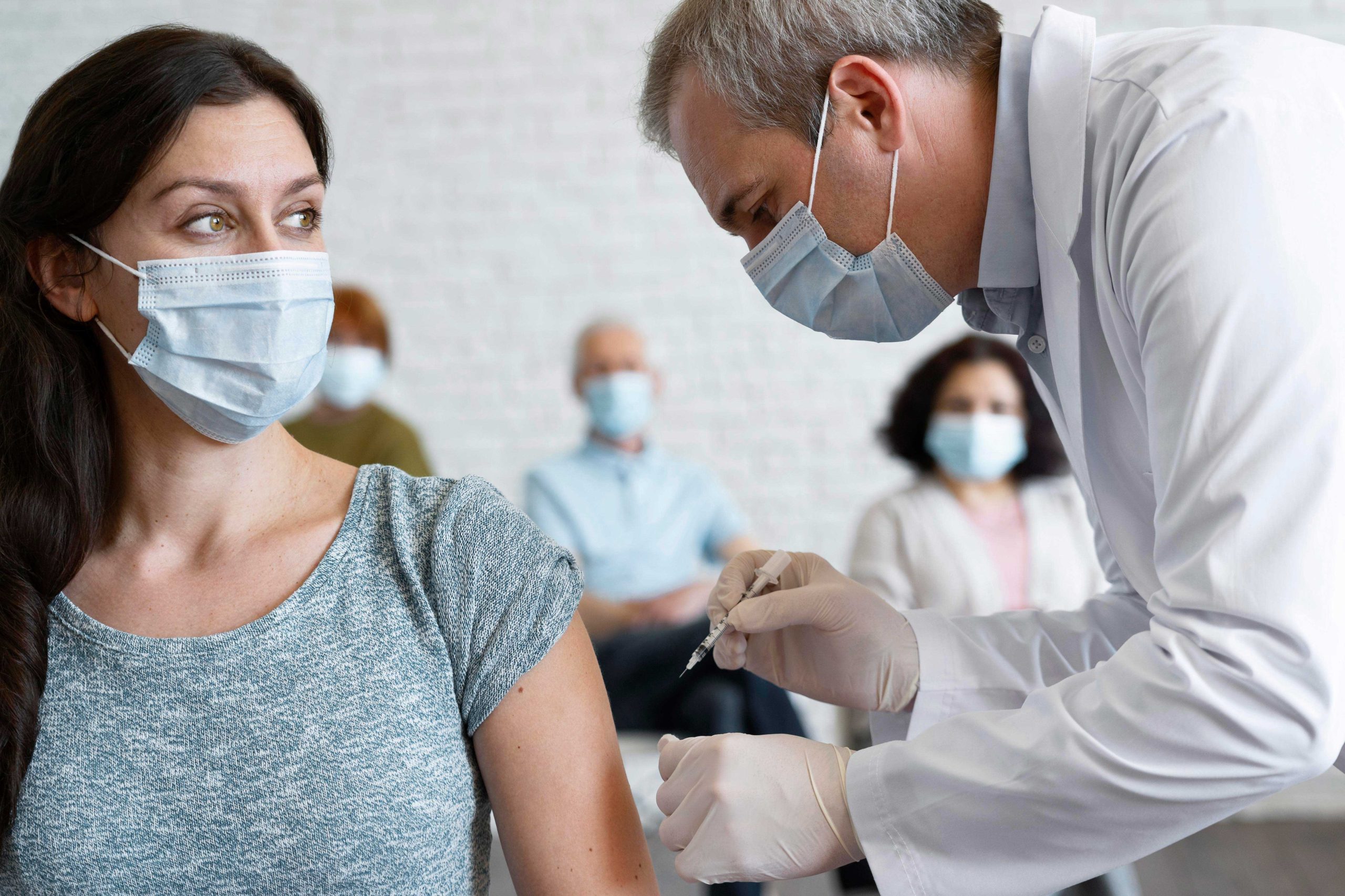Risks and Rewards
The swift development and distribution of COVID-19 vaccines have been instrumental in combating the pandemic. Yet, concerns about adverse effects, spanning from mild symptoms to severe health complications, have ignited considerable debate. Establishing a scientific basis is crucial for comprehending the relationship between the vaccine and its adverse effects.
By Prof Ramesh K. Goyal

In recent times, there have been numerous reports highlighting serious adverse effects associated with the COVID-19 vaccine. It has become common to link many instances of death due to cardiovascular complications around the world to the COVID-19 vaccine. Today when there is unrestricted access to medical reports and publications, public awareness regarding the effects of COVID-19 vaccines has significantly increased. Many individuals, unaware of the intricacies of regulatory bodies such as the Food and Drug Administration (FDA) in the United States or the Central Drugs Standard Control Organisation (CDSCO) in India, often criticise these agencies and the government for perceived lapses.
However, regulatory bodies like the FDA and CDSCO have stringent obligations when it comes to authorising the use of any vaccine or drug. Even after a vaccine is authorised for marketing, healthcare providers are required to report any death following COVID-19 vaccination to the Vaccine Adverse Event Reporting System (VAERS), regardless of whether it is clear that the vaccine was the cause.
Role of Vaccines in Controlling Epidemics
Historically, vaccines have been the ultimate solution for controlling epidemics and pandemics. However, introducing a vaccine to the public involves extensive processes, checks, and balances conducted by regulatory bodies. In the medical field, it is often said that “emergency knows no rule,” but it is also acknowledged that adverse effects from drugs, including vaccines, especially those due to idiosyncrasies, can be unpredictable and severe.
One of the biggest challenges in treating viral diseases is the mutations that can hinder efforts to quickly end a pandemic. While developing antiviral drugs is crucial, it may not be the sole solution. Understanding the pathophysiology of the virus and developing strategies to manage the consequences of infection have been key in saving lives long before the discovery of chemotherapeutic agents.

Mandatory Reporting of Adverse Effects in Clinical Trials
Globally, before any new drug or vaccine is released to the market, it must undergo three phases of clinical trials. Regulatory agencies establish guidelines for these phases to ensure the safety of volunteers.
Phase 1: This initial phase focuses on safety and involves 20-100 healthy volunteers. Scientists begin to determine the appropriate dose size and assess both efficacy and safety.
Phase 2: If no serious side effects are found in Phase 1, Phase 2 involves several hundred volunteers. This phase provides additional information on common short-term side effects and how the dose size relates to the immune response.
Phase 3: Hundreds or thousands of volunteers participate in this phase. In the case of vaccines, the vaccinated subjects are compared with those who might have received a placebo or another vaccine to identify common side effects.
These phases are crucial in ensuring that any new drug or vaccine is both safe and effective before it is made available to the public.
Regulatory Oversight
Clinical trials are conducted only after receiving approval from regulatory agencies. These agencies review the trials to ensure they adhere to the highest scientific and ethical standards. The results of these trials are essential part of the FDA evaluation process.
In addition to clinical trial results, a high-power committee comprising scientists, medical professionals, legal experts, social scientists, and subject specialists meticulously evaluates information. This includes studies on the physical, chemical, and biological properties of the vaccine, as well as details about its manufacturing process. The goal is to ensure the vaccine can be produced consistently safe, pure, and potent.
The trials and all related data must demonstrate that the vaccine’s benefits outweigh its potential risks (side effects) for the people who will be recommended to receive it. Only when a vaccine’s benefits are found to outweigh its potential risks does the FDA grant a license, allowing it to be used by the public.
Post-Marketing Surveillance
Once a vaccine or drug is licensed and released into the market, it enters the post-marketing surveillance phase. For vaccines, this is managed through the VAERS. It is a national system used by scientists at the FDA and the Centers for Disease Control and Prevention (CDC) to collect reports of adverse events (possible side effects) that occur after vaccination.
Reporting Adverse Events
Healthcare professionals, vaccine manufacturers, vaccine recipients, and family members of those who have received a vaccine are encouraged to submit reports to VAERS if they experience any adverse events after vaccination. In India, a similar system is in place through the Pharmacovigilance Programme of India (PvPI) at the Indian Pharmacopoeia Commission in Faridabad.
Scientists continuously monitor VAERS reports to identify potential adverse events, including serious ones, which are reviewed by medical professionals daily. VAERS data provide crucial signals of potential adverse events, helping to detect unexpected patterns or higher-than-expected occurrence rates. Follow-up studies are conducted to investigate these signals further.
Beyond VAERS, there are other systems such as the Vaccine Safety Datalink (VSD), which help to determine if side effects identified through VAERS are actually related to the vaccination.
The FDA also uses the Post-Licensure Rapid Immunization Safety Monitoring (PRISM) system, the largest vaccine safety surveillance system in the US. PRISM actively monitors and analyses data from a representative subset of the general population. By linking data from health plans with state and city immunisation registries, PRISM accesses information for over 190 million people, enabling the FDA to identify and analyse rare health outcomes that would otherwise be difficult to assess.
Understanding Side Effects and Adverse Events
Adverse events reported to VAERS are not necessarily side effects caused by vaccination. An adverse event is a health problem that happens after vaccination and may or may not be caused by the vaccine. A side effect, by definition, has been shown to be linked to a vaccine through scientific studies.
During clinical trials, various methods are used to track, categorize, and assess any side effects at each stage. An adverse event, whether expected or spontaneous, is initially graded on a scale of 1 to 5, with grade 1 being mild and non-bothersome, and grade 5 being fatal.
Serious Adverse Events: These are adverse events that cause death, persistent incapacity, induce congenital disabilities, or result in other serious injuries. They are distinguished from adverse reactions that occur during clinical trials but may not be related to the therapy being investigated.
Suspected Unexpected Adverse Events: These are adverse events that are extremely atypical for the medication or therapy applied but may still be related to the trial, thus raising suspicion of involvement.
Understanding these categories and the rigorous processes in place helps ensure that the benefits of vaccines and drugs outweigh their risks, providing a robust framework for public health safety.
Common Adverse Events and Reporting Mechanisms
Adverse events following vaccination can include localised pain, fatigue, headaches, and other typical ailments. Many of these events are considered preventable according to some meta-studies. Commonly reported adverse events also stem from infections acquired in clinical or hospital settings, surgical errors, and mistakes in medication administration.
Identification of Adverse Events in Clinical Trials
By the time a therapy reaches broad-scale human trials, rigorous safety experiments have been conducted, identifying probable adverse events related to the drug’s mechanism of action. However, some adverse events might still be discovered at this stage, especially through meta-studies of clinical trials in specific sub-sets of the population. These adverse events can sometimes be overestimated due to the regression to the mean effect, where random noise causes extreme examples to appear as overestimates of the true effect.
Potential for Missed Side Effects During Clinical Trials
The relatively short duration of clinical trials means that long-term side effects might be missed. Some medications have been withdrawn from the market post-release due to long-term adverse effects not identified during the trials. For example, valdecoxib was withdrawn in 2005 due to cardiovascular events and severe skin reactions, and efalizumab was withdrawn in 2009 due to its association with progressive multifocal leukoencephalopathy.
Case Studies of EUA Implementation
The COVID-19 pandemic posed unprecedented challenges due to several pressing issues:
•Unknown Characteristics: Initially, the characteristics of the virus were not fully understood.
•Unknown Pathophysiology: The disease’s pathophysiology was unclear.
•Clinical Confusion: There was confusion over the clinical consequences and their correlation with the disease’s pathophysiology.
•Drug Repurposing: Treatment relied on repurposing existing drugs and symptomatic management.
•Rapid Transmission: The virus spread at an exceptional speed.
•Genomic Variation: The virus exhibited significant genomic variation and mutations.
•High Morbidity and Mortality: The pandemic resulted in rapid morbidity and mortality.
Given these circumstances, the Emergency Use Authorisation (EUA), became a critical regulatory mechanism to address the crisis. The EUA allows the use of vaccines and medicines to prevent or mitigate life-threatening conditions when no standard treatment is available, and there is insufficient time to complete the usual clinical trial process.
India’s CORBEVAX: India’s first indigenously developed receptor binding domain (RBD) protein sub-unit vaccine for COVID-19, CORBEVAX, developed by Biological E Limited, received EUA from the Drug Controller General of India (DCGI).
Pfizer/BioNTech COVID-19 Vaccine: The World Health Organization (WHO) listed the Comirnaty COVID-19 mRNA vaccine for emergency use, making it the first vaccine to receive emergency validation post-outbreak. This enabled countries to expedite regulatory approvals, allowing for rapid import and administration of the vaccine. It also facilitated procurement by UNICEF and the Pan-American Health Organization for distribution to countries in need.
The Pfizer-BioNTech vaccine has been authorised for emergency use by the FDA for individuals aged six months through 11 years to prevent COVID-19. This authorisation is in place under EUA and remains effective until the circumstances justifying the authorisation change.
The WHO convened regulatory experts worldwide to review data on the Pfizer/BioNTech vaccine’s safety, efficacy, and quality as part of a risk-versus-benefit analysis. Dr Mariângela Simão, WHO Assistant-Director General for Access to Medicines and Health Products, emphasises the importance of global efforts to ensure sufficient vaccine supply for priority populations.
Safety Information for Pfizer-BioNTech COVID-19 Vaccine:
•Allergic Reactions: Individuals with a history of severe allergic reactions to any ingredients in the Pfizer-BioNTech COVID-19 vaccine should not receive it. Severe allergic reactions usually occur within minutes to one hour after vaccination. Symptoms include difficulty breathing, swelling of the face and throat, fast heartbeat, rash, dizziness, and weakness. Immediate medical attention is required if these symptoms occur.
•Myocarditis and Pericarditis: These conditions have been reported, particularly in adolescent males aged 12 to 17 years, typically within a few days post-vaccination. Symptoms include chest pain, shortness of breath, and feelings of a fast or fluttering heartbeat. Medical attention should be sought immediately if these symptoms occur.
•Other Potential Side Effects: Common side effects include injection site pain, tiredness, headache, muscle pain, chills, joint pain, fever, injection site swelling/redness, nausea, feeling unwell, swollen lymph nodes, decreased appetite, diarrhoea, vomiting, arm pain, fainting, dizziness, and irritability.
Special Considerations
•Monitoring Post-Vaccination: Recipients are usually asked to stay for monitoring after vaccination to manage potential immediate adverse reactions.
•People with Weakened Immune Systems: These individuals may have a reduced immune response to the vaccine.
•Pregnancy and Breastfeeding: Recipients should inform the vaccination provider if they are pregnant, breastfeeding, or have received another COVID-19 vaccine.
•Pre-existing Conditions: Individuals with allergies, a history of myocarditis or pericarditis, fever, bleeding disorders, or those on blood thinners or immunosuppressive medication should inform their vaccination provider.
Reporting and Monitoring Systems
•VAERS: This system is used to collect reports of adverse events following vaccination. This system helps in detecting potential adverse events.
•VSD: This system determines if side effects identified via VAERS are related to vaccination.
•PRISM: It is the largest vaccine safety surveillance system in the US, actively monitoring data from a representative subset of the population.
Adverse Effects and Reporting Systems
While the known side effects of vaccines, such as localised pain, fatigue, headache, and other ailments, are well-documented, it’s crucial to acknowledge that unexpected and serious side effects may also occur. If side effects become bothersome or persist, individuals are advised to contact their healthcare provider. Reports of vaccine side effects can be submitted to the FDA, CDC, or through the VAERS.
Takeaways
Globally, the norms for introducing a drug or vaccine are stringent, allowing minimal scope for adverse effects. However, during the COVID-19 pandemic, the urgency necessitated a balance between risks and benefits. EUA provided a framework to deploy vaccines quickly to combat the pandemic, underscoring the need for rapid yet safe medical responses in times of crisis.
Understanding the potential adverse events and the systems in place for reporting and monitoring these events is crucial. Despite rigorous clinical trials and safety protocols, some side effects and adverse events can emerge post-authorisation, necessitating ongoing vigilance and research to ensure public health safety.
The author is Adviser to ITM SLS Baroda University and ITMBU Medical Hospital, Vadodara, and former Vice Chancellor of Delhi Pharmaceutical Sciences & Research University, New Delhi.

